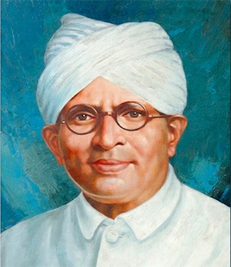Seth Walchand Hirachand (1882 - 1953)

"You will be making
a great contribution to
building up of an essential national
industry under the
control direction and
management of Indians
if you succeed."
-Dr.Rajendra Prasad
President of India, 1941
In 1923, Seth Walchand Hirachand, an ambitious industrialist, arrived in Ravalgaon with the belief that India could improve its economic condition and free itself of colonial exploitation if it developed its own industries using modern technology. He realized that agriculture, India's single largest industry, would have to partake in this revolution.
He bought 1,500 acres of barren land and set about clearing it of rocks and stones, replacing them with fertile soil. He engaged the services of experienced agriculturists, chemists and engineers. After a decade of persistence, he developed sugarcane in the region and erected one of India's first sugar mills. Around this mill rose a township that provided healthcare, education and employment to an otherwise remote, rural community. The Ravalgaon Sugar Farm Limited was thus incorporated in 1933. In the 1940s, it used some of its sugar output to develop confectionery under the Ravalgaon brand.
The agricultural model developed at Ravalgaon was replicated by Seth Walchand in 1934 in Kalamb, near Pune. The prosperous township that developed has since been rechristened Walchandnagar. It is home to Walchandnagar Industries Limited, which has evolved from its sugar-milling roots to manufacture heavy-engineering products for sugar, cement and power plants. The sugar revolution in Maharashtra, sparked off by Ravalgaon and Walchandnagar's unprecedented success, is often credited to Seth Walchand. Today Maharashtra is the largest sugar producing state in India.
Seth Walchand earned his stripes in construction, taking on some of the most challenging projects at the time. Those early successes laid the foundations for the Hindustan Construction Company, which today includes amongst its many accomplishments the Bandra-Worli Sea Link in Mumbai and the model township of Lavasa near Pune, and the Indian Hume Pipe Limited.
Another of his ambitions was to see ships, planes and cars being built in India by its own people. He set up Hindusthan Aircraft Company in 1940 and a shipyard in 1946 in Vishakhapatnam. Both of these were deemed so strategically important that they were later nationalized and renamed Hindustan Aeronautics Limited and Hindustan Shipyard Limited, respectively. The Premier Automobiles Limited rolled out its first trucks and cars in 1947, the year of India's independence. Even today the ubiquitous and iconic Premier Padmani, or Fiat, dots the streets of Mumbai as yellow-roofed taxis.
Seth Walchand laid down a strategic vision for an independent India and played his part through his own boundless enterprise.
